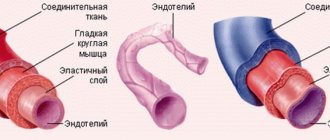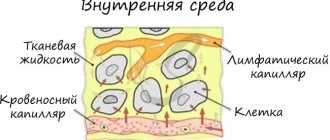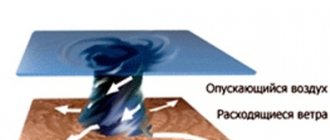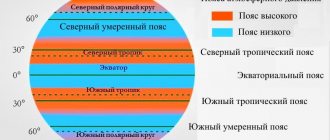Updated July 20, 2021 162 Author: Dmitry Petrov
Hello, dear readers of the KtoNaNovenkogo.ru blog.
Cyclones and anticyclones are moving atmospheric vortices that move gigantic volumes of air masses and determine the nature of the weather over vast areas.
Their sizes are colossal: up to 3 thousand km in diameter and up to 16 km in height.
These powerful atmospheric formations have a similar formation mechanism, but in essence they are antipodes (this can be seen even by their name). Let's look at both of these phenomena in more detail.
Cyclone is...
A cyclone is an atmospheric vortex with low air pressure in the center and winds directed from the periphery to the center. Indicated by the letter H (low pressure zone).
In the northern hemisphere, the air mass swirls counterclockwise, and in the southern hemisphere, clockwise, but in any case the air flow is directed upward .
The formation of a cyclone is caused by the collision of air masses with different temperatures, in other words, the advance of a warm air front on a cold one.
Depending on the area of occurrence, the following types of cyclones :
- Arctic;
- mid-latitude cyclones;
- tropical.
The development of a cyclone occurs in several stages, namely:
- The beginning is the formation of air currents, which can last several days.
- Youth – a drop in pressure in the central region and the appearance of thick clouds.
- Maturity - the pressure drops to its maximum value, and the wind speed increases to its maximum value. The stage lasts from several hours to several days.
- Attenuation - the cyclone gradually loses strength, moving from the water area to land.
The most powerful are tropical cyclones, which form over a well-warmed sea area within the equatorial belt (at latitudes from 5 to 25 degrees).
They are not as extensive as cyclones in temperate latitudes, but they carry enormous destructive power. Depending on the place of origin, such cyclones are called hurricanes, typhoons or lassoes.
As the center of a tropical cyclone approaches, a sharp drop in atmospheric pressure occurs, and piles of heavy shower clouds appear instead of cirrus clouds.
For some time there is a lull and suffocating heat, after which the air temperature drops and heavy rain , giving way to tropical downpour.
Time in Antananarivo, Madagascar now
Such a cyclone as a whole (or its center) has a forward motion and often causes great excitement, much greater than in the most severe storms of temperate latitudes.
The speed of a tropical cyclone varies from 70 to 240 miles per day, increasing with increasing latitude. Atmospheric pressure in a tropical cyclone decreases from the periphery to the center to 950-970 mb,
and in some cases it drops even lower, while the wind speed, on the contrary, increases and near the central zone of the tropical cyclone reaches its highest values, equal to 40-60
m/sec
or even more. However, in the very central zone of the tropical cyclone, 20 to 30 miles in diameter, winds weaken to calm.
The passage of a tropical cyclone is always accompanied by heavy clouds, very heavy and prolonged downpours and significant waves. In the central zone of a tropical cyclone (the "eye of the storm") the sky is usually clear or covered with thin altostratus clouds; The excitement here takes on the character of a strong crush. posing a great danger to the ship. Tropical cyclones occur in all oceans.
The main centers of origin and their local names are as follows:
· Caribbean Sea and Gulf of Mexico. The cyclones that arise here are called Antillean hurricanes
· Philippine Islands region, South China Sea, tropical cyclones are called typhoons
· Arabian Sea and Bay of Bengal, where tropical cyclones have no local name
· Indian Ocean off the coast of Australia. Here tropical cyclones are called "willy-willy"
· in the Pacific Ocean off the west coast of Mexico - cordonazo
· in the Philippines - baguyo, or baruyo
· In the southern Indian Ocean, east of the island of Madagascar. The local name for tropical cyclones is “orcans”.
Tropical cyclones often originate in the open ocean, usually between 5 and 20° latitude, at the boundaries of the zone of prevailing light winds and calms and in monsoon areas. At the first stage of their movement, tropical cyclones move at a low speed of 10-20 km/h to the west, then the speed increases to 30-40 km/h or more.
Then, increasingly deviating to the right in the northern hemisphere and to the left in the southern hemisphere, they begin to move to the northwest and southwest, respectively. Having reached the border of the trade wind zone, i.e., approximately 15-30 °, northern and southern latitude, tropical cyclones, if they have not yet filled by this time, change the direction of movement and begin to move to the northeast in the northern hemisphere and to the south -east in south. Some tropical cyclones, however, do not change direction but continue to move in a northwest or southwest direction until they reach the mainland. As it enters temperate latitudes, the cyclone gradually fills and slows down its movement. But when a cyclone penetrates into a system of colder air (into the region of the polar front), it transforms: it deepens, its speed increases (sometimes up to 60 km/h), the zone of storm winds expands, etc. And as an extratropical vortex, it can shift at fairly high latitudes. As the tropical cyclone enters the continent, it quickly weakens and dies out. Tropical cyclones are most often observed in the northern hemisphere from August to September, and in the southern hemisphere in the Pacific Ocean - from January to July, in the Indian Ocean - from November to April. The exception is the northern Indian Ocean, where tropical cyclones are more common from May to December.
An anticyclone is...
An anticyclone is an atmospheric vortex with increased air pressure in the center and winds directed from the center to the edges. Indicated by the letter B (high pressure area).
In the northern hemisphere, the air swirls clockwise, and in the southern hemisphere, counterclockwise, but in any case it descends from the upper layers of the atmosphere (mainly from the troposphere) to the surface of the earth.
The reasons for the formation of anticyclones are the same as in the case of cyclones: the collision of warm and cold air fronts. However, they are formed mostly in subtropical and polar regions.
Anticyclones move slower than cyclones (their speed usually does not exceed 40 km/h), and sometimes they can “hang” in one place for a long time, forming a stable climatic zone.
Anticyclones are divided into :
- low, where cold air currents predominate, and the area of high pressure ends at an altitude of about 1.5 km;
- high, where warm air currents predominate, and the area of high pressure extends throughout the troposphere (up to 16 thousand km).
An anticyclone is characterized by clear, dry and windless weather . In summer it gets hot, in winter it gets cold.
At the same time, there is a sharp change in air temperature throughout the day, especially in the interior of the continental part. It happens that the difference between day and night values reaches 20 degrees Celsius (in Siberia this is not so uncommon).
A record drop of 55.5 C was recorded in January 1916 in Browning (Montana, USA), where the temperature dropped from +6.70 C to -48.80 C during the day.
Snake Ring
Cyclones (gr. “snake ring”) are huge vortices, the diameter of which can often reach several thousand kilometers. They are formed in temperate and polar latitudes, when warm air masses from the equator collide with dry, cold currents moving towards them from the Arctic (Antarctica) and form a boundary between themselves, which is called an atmospheric front.
Cold air, trying to overcome the warm air flow remaining below, in some area pushes part of its layer back - and it comes into collision with the masses following it. As a result of the collision, the pressure between them increases and part of the warm air turned back, yielding to the pressure, is deflected to the side, beginning an ellipsoidal rotation.
This vortex begins to capture the layers of air adjacent to it, draws them into rotation and begins to move at a speed of 30 to 50 km/h, while the center of the cyclone moves at a lower speed than its periphery. As a result, after some time the diameter of the cyclone ranges from 1 to 3 thousand km, and the height – from 2 to 20 km.
Where it moves, the weather changes sharply, since the center of the cyclone has low pressure, there is a lack of air inside it, and cold air masses begin to flow in to make up for it. They displace warm air upward, where it cools, and the water droplets in it condense and form clouds, from which precipitation falls.
The lifespan of a vortex is usually from several days to weeks, but in some regions it can last about a year: usually these are areas of low pressure (for example, the Icelandic or Aleutian cyclones).
It is worth noting that such vortices are not typical for the equatorial zone, since the deflecting force of the planet’s rotation, necessary for the vortex-like movement of air masses, does not act here.
The southernmost, tropical cyclone, forms no closer to the equator than five degrees and is characterized by a smaller diameter, but higher wind speed, often transforming into a hurricane. According to their origin, there are such types of cyclones as the temperate cyclone and the tropical cyclone, which generates deadly hurricanes.
Similarities and differences between cyclones and anticyclones
The similarity between cyclones and anticyclones lies in the fact that they have the same mechanism of occurrence, associated with the axial rotation of the planet and uneven heating of the earth's surface. Both have a vortex-like structure and influence weather conditions over large areas.
The life cycle of both phenomena is approximately the same, on average from 3 to 10 days (this period is sufficient to equalize the atmospheric pressure). However, among them there are also long-lived ones, such as the Icelandic and Aleutian cyclones, the Asian (Siberian) and South Indian anticyclones.
However, in general these are completely opposite phenomena. In principle, by reading about the cyclone and reversing its main characteristics, you can get a general idea of the anticyclone.
The main differences are shown in the table below.
| Index | Cyclone | Anticyclone |
| Field of education | Over the oceans at all latitudes except equatorial | Over the oceans in the subtropics and polar latitudes |
| Diameter | 100-1000 km | Up to 3000 km |
| Travel speed | Up to 60 km/h, for hurricanes and typhoons up to 200 km/h | Up to 40 km/h |
| Pressure distribution | Decreased in the center, increases towards the periphery | Increased in the center, decreases towards the periphery |
| Vortex rotation direction | Counterclockwise in the northern hemisphere, clockwise in the southern hemisphere | Clockwise in the northern hemisphere, counterclockwise in the southern hemisphere |
| Weather | Cloudy, precipitation, strong wind | Clear, calm, hot (summer) or cold (winter) |
| Designation on a synoptic map | H (low pressure zone) | B (high pressure zone) |
Vortexes of tropical latitudes
In the 1970s, tropical cyclone Bhola hit Bangladesh. Although the wind speed and strength were low and it was assigned only the third (out of five) hurricane category, due to the huge amount of precipitation that fell on the ground, the Ganges River overflowed its banks and flooded almost all the islands, washing away all settlements from the face of the earth.
The consequences were catastrophic: during the rampant disaster, from three hundred to five hundred thousand people died.
A tropical cyclone is much more dangerous than a vortex from temperate latitudes: it forms where the temperature of the ocean surface is not lower than 26°, and the difference between air temperatures exceeds two degrees, as a result of which evaporation increases, air humidity increases, which contributes to the vertical rise of air masses.
Thus, a very strong draft appears, capturing new volumes of air that have heated up and gained moisture above the ocean surface. The rotation of our planet around its axis gives the rise of air the vortex-like movement of a cyclone, which begins to rotate at enormous speed, often transforming into hurricanes of terrifying force.
A tropical cyclone is formed only over the ocean surface between 5-20 degrees north and south latitudes, and once on land, it fades out quite quickly. Its dimensions are usually small: the diameter rarely exceeds 250 km, but the pressure at the center of the cyclone is extremely low (the lower, the faster the wind moves, so the movement of cyclones is usually from 10 to 30 m/s, and wind gusts exceed 100 m/s) . Naturally, not every tropical cyclone brings death with it.
There are four types of this vortex:
- Disturbance – moves at a speed not exceeding 17 m/s;
- Depression - the movement of the cyclone is from 17 to 20 m/s;
- Storm - the center of the cyclone moves at a speed of up to 38 m/s;
- Hurricane - a tropical cyclone moves at a speed exceeding 39 m/s.
The center of this type of cyclone is characterized by a phenomenon called the “eye of the storm” - an area of calm weather. Its diameter is usually about 30 km, but if a tropical cyclone is destructive, it can reach up to seventy. Inside the eye of the storm, the air masses have a warmer temperature and less humidity than in the rest of the vortex.
Calm often reigns here; at the border, precipitation abruptly stops, the sky clears, the wind weakens, thereby deceiving people who, deciding that the danger has passed, relax and forget about precautions. Since a tropical cyclone always moves from the ocean, it drives huge waves in front of it, which, when they hit the coast, sweep everything out of the way.
Scientists are increasingly recording the fact that every year the tropical cyclone becomes more dangerous and its activity is constantly increasing (this is due to global warming). Therefore, these cyclones are found not only in tropical latitudes, but also reach Europe at an atypical time of year for them: they usually form in late summer/early autumn and never occur in spring.
Thus, in December 1999, France, Switzerland, Germany, and the UK were hit by Hurricane Lothar, so powerful that meteorologists could not even predict its appearance due to the fact that the sensors either went off scale or did not work. “Lotar” turned out to be the cause of the death of more than seventy people (they were mainly victims of road accidents and falling trees), and in Germany alone, about 40 thousand hectares of forest were destroyed in a few minutes.
What is a tropical cyclone
From cyclones formed in temperate latitudes, cyclones that owe their origin to the tropics are separated. They have many names. These are hurricanes (West Indies), and typhoons (east Asia), and simply cyclones (Indian Ocean), and arcana (southern Indian Ocean). The sizes of such vortices range from 100 to 300 miles, and the diameter of the center is from 20 to 30 miles.
The wind here accelerates to 100 km/h, and this is typical for the entire vortex area, which fundamentally distinguishes them from cyclones formed in temperate latitudes. A sure sign of the approach of such a cyclone is ripples in the water. Moreover, it goes in the opposite direction to the blowing wind or the wind that blew shortly before.
Names of vortices
In the middle of the last century, anticyclones and cyclones began to be given names: this turned out to be much more convenient when exchanging information about hurricanes and cyclone movements in the atmosphere, since it made it possible to avoid confusion and reduce the number of errors. Behind each name of a cyclone and anticyclone there was hidden data about the vortex, down to its coordinates in the lower layer of the atmosphere.
Before making a final decision on the name of this or that cyclone and anticyclone, a sufficient number of proposals were considered: they were proposed to be designated by numbers, letters of the alphabets, names of birds, animals, etc. This turned out to be so convenient and effective that after a while Over time, all cyclones and anticyclones received names (at first they were female, and in the late seventies tropical vortices began to be called by male names).
Since 2002, a service has appeared that offers anyone who wants to name a cyclone or anticyclone by their name. The pleasure is not cheap: the standard price for a cyclone to be named after a customer is 199 euros, and an anticyclone costs 299 euros, since anticyclones occur less frequently.









